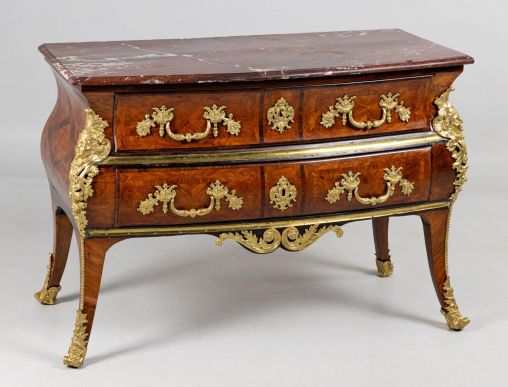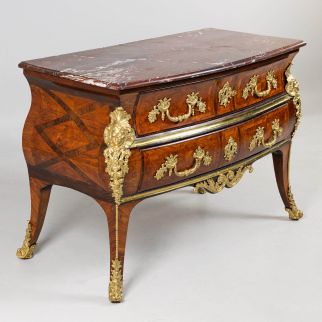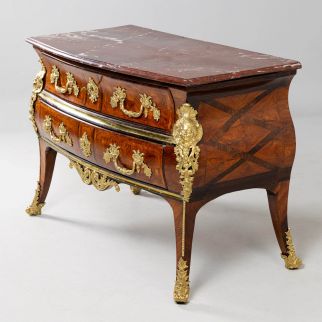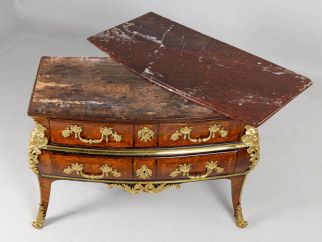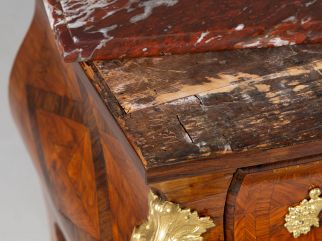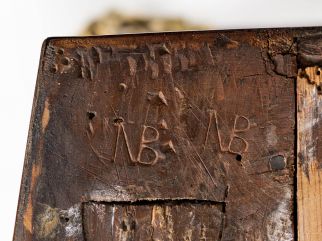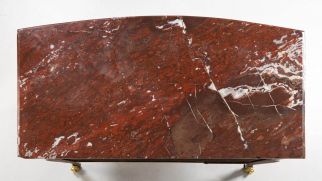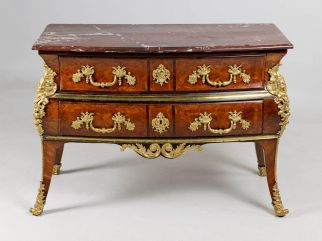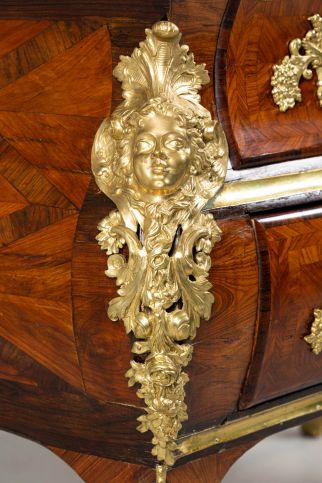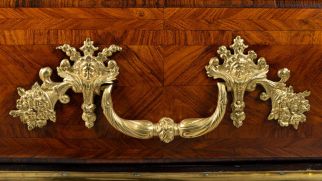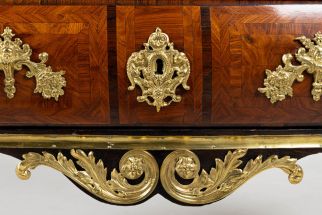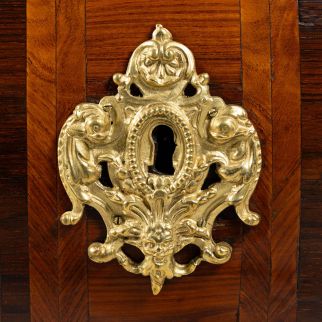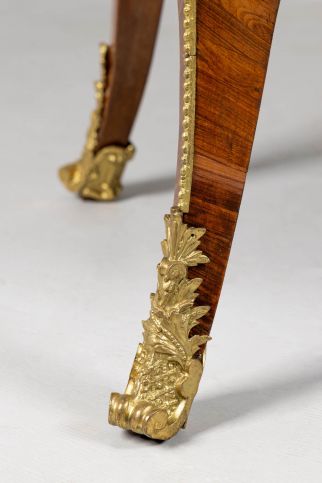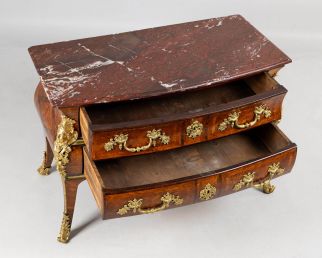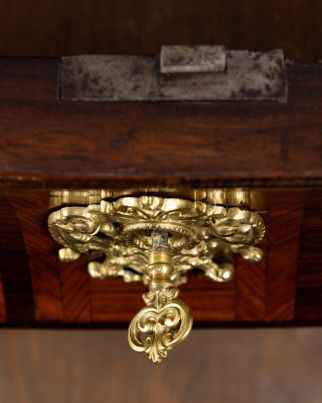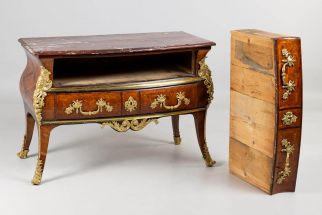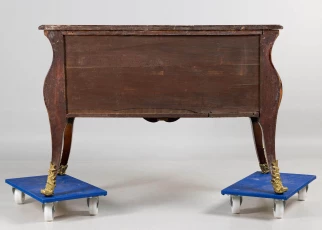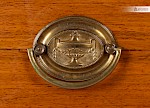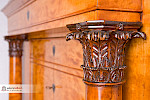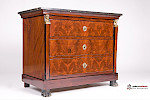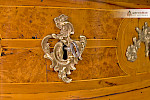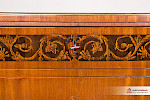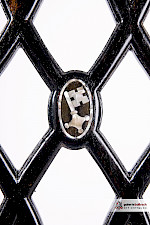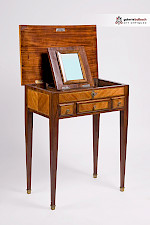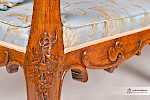Regence chest of drawers from the workshop of Nicolas Bernard
France
Kingwood
Mid 18th century
Dimensions: H × W × D: 83 × 125 × 62 cm
Description:
This fine Regence or Louis XV chest of drawers with a curved front and elegantly curved body is a characteristic example of Parisian furniture art from around 1750.
The body rests on four high, curved legs and supports the perfectly fitting, original top panel made of Griotte marble, which was quarried in the French Pyrenees and enjoyed great popularity with some Parisian ebenists of the time due to its strong red veining.
The veneered surface features a lively interplay of kingwood(bois de violette) laid in a herringbone pattern, framed by dark band inlays. The wood forms the perfect backdrop for the elaborately designed fittings.
The veneer is structured on the sides by diamond-shaped and mitred bands - a classic design that was popular in the Époque Régence and early Louis XV.
The exceptionally high-quality bronze decoration of the chest of drawers is particularly impressive:
The pilaster strip fittings show finely chiselled female faces on a lavish rocaille cartouche. The flowing hair of the mascarons ends at the bottom in a symmetrical leaf ornament with deeply sculpted decoration in which roses and other flowers merge together. A typical fitting used in the workshop of Nicolas Bernard.
A pearl bar creates the connection to the magnificent bronze sabots mounted on the feet of the chest of drawers.
The key plates show key guides framed by a string of pearls and flanked by dolphin-like mythical creatures. At the top we see a crown of shells, the lower end is formed by an abstract rocaille with a grimacing mask - another iconic motif in the Rococo decorative style.
The pull fittings consist of a transverse, leaf-shaped handle, held on both sides by symmetrical volutes with small mascarons, which run outwards into lush leaf and flower bouquets - a characteristic design that is also found several times on chests of drawers from the workshop of Nicolas Bernard.
If we pull out the top drawer completely, we can see the dust shelf set into the body between the two drawers, which not only prevents dust or small parts from falling through, but also provides additional stability to the body construction - a detail typical of the period for chests of drawers of the quality found here.
The original, functional iron locks are also typical of the period and region.
Below the marble top, the chest of drawers is labelled with the master's stamp "N.B.". The execution of the veneer work as well as the choice of motifs and the quality of the bronzes speak in favour of a confirmed origin from the workshop of Nicolas Bernard.
Interesting facts:
Nicolas Bernard was born around 1713 and became a master ébéniste in Paris in 1742. He initially worked as a freelance craftsman in the Rue du Faubourg-Saint-Antoine, the centre of Parisian furniture craftsmanship, and later set up his own workshop there.
His work is characterised by the curved body shapes in the taste of the Régence period, as well as rich veneer design and the finest bronze work. The initials "N.B." can be found on several surviving pieces of furniture, including a stylistically related chest of drawers that was auctioned in Paris in 2000(see Pierre Kjellberg - Le mobilier français du XVIIIe siècle p. 67). The fittings documented there correspond exactly to those of the chest of drawers offered here in terms of motif, construction and finish.
Condition:
Authentic, restored condition with a shellac polish. The bronzes have been cleaned and are also in a very desirable condition.
Price: 13500,-€
Please compare the following specialised literature:
Pierre Kjellberg - Le Mobilier Français du XVIIIe Siècle p. 67
Article found under: Chests of drawers
Add to shopping cartVideo chest of drawers Nicolas Bernard
Also interesting
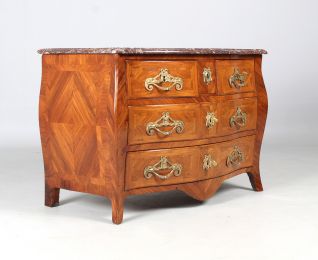
Fine Louis XV chest of drawers
France
Rosewood
Mid 18th century
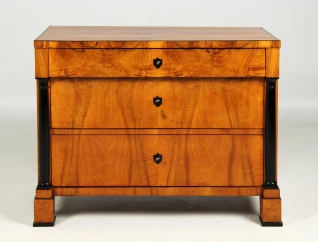
Biedermeier chest of drawers with half-columns
Southern Germany
Walnut
Biedermeier around 1825
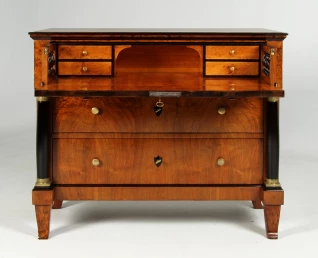
Antique chest of drawers with lyre capitals
Southern Germany (Franconia)
Walnut
Biedermeier around 1825
